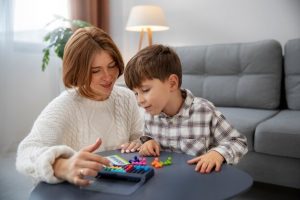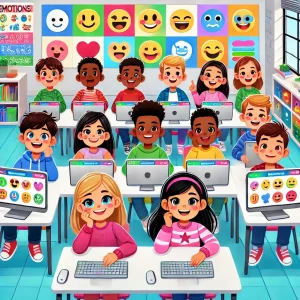Understanding Social Emotional Learning: Importance for kids
By Rajini D
Last Updated: February 12, 2025
Social Emotional Learning (SEL) is a transformative approach to fostering fundamental life skills in children and adults. At its core, SEL involves understanding and managing emotions, setting and achieving positive goals, showing empathy for others, building and maintaining positive relationships, and making responsible decisions. These capabilities are crucial not only in school settings but across all aspects of life.
Why is SEL Important for Children?
In the early stages of development, children are like sponges, absorbing information and cues from the world around them. Integrating Social Emotional Learning into their daily life is more than just an educational strategy; it’s essential for holistic development. SEL equips children with the tools they need to navigate the complexities of interpersonal relationships, academic challenges, and personal growth.
By nurturing emotional intelligence from a young age, SEL helps children develop into well-rounded individuals who understand their feelings and the feelings of others. This awareness is pivotal as it enhances their ability to communicate effectively, solve problems collaboratively, and make thoughtful, empathetic decisions. These skills lay the foundation for lifelong learning and success, extending benefits that reach far beyond the classroom.
Also read: Growing Impact of Online Social Emotional Learning on Schools
Importance of SEL in Early Education
Why is SEL Crucial in the Formative Years?
The formative years are a critical period in a child’s development, serving as the foundation for future learning and behavior. Integrating Social Emotional Learning (SEL) during this phase is not just beneficial—it’s essential. SEL provides children with a framework to develop critical thinking, emotional management, and social skills. These skills are integral to navigating the complexities of growing up and help foster a sense of identity and belonging.
Impact of SEL on Managing Emotions and Behaviors
One of the most significant benefits of SEL in early education is its impact on a child’s ability to understand and manage emotions. Children are often faced with feelings they don’t understand and situations they can’t control. Through SEL, they learn to identify their emotions, understand the triggers, and develop healthier ways to express themselves. This emotional intelligence is crucial for building resilience against stress and adversity—skills that will benefit them throughout their lives.
SEL’s Contribution to a Supportive and Inclusive Learning Environment
Social Emotional Learning also plays a pivotal role in creating a supportive and inclusive educational atmosphere. By fostering empathy and mutual respect among students, SEL encourages an understanding of diverse cultures and backgrounds. This understanding is key to promoting inclusivity, reducing bullying, and enhancing peer relationships.
A classroom that embraces SEL becomes a community where every student feels seen, heard, and valued. This inclusive environment not only enhances students’ academic achievements but also supports their emotional and social well-being. It prepares them to thrive in a multicultural world, respecting and celebrating differences as much as similarities.
Core Components of Social Emotional Learning (SEL)
Self-awareness: Understanding Emotions and Reactions
Self-awareness is the cornerstone of Social Emotional Learning, acting as the initial step in recognizing one’s own emotions and understanding their impact. For children, developing self-awareness means gaining the ability to identify what they feel and why they feel it. This awareness helps children comprehend their own reactions to situations, which is essential for emotional growth and stability. By fostering self-awareness, children learn to pinpoint their strengths and weaknesses, contributing to a better sense of self-esteem and confidence. Activities like journaling or reflecting on their day can assist in cultivating this crucial skill.
Self-management: Techniques for Emotional Regulation and Decision-Making
Once children become aware of their emotions, the next step is learning self-management, which involves controlling their reactions and making responsible choices. Techniques such as deep breathing, counting to ten, or discussing feelings with a trusted adult are simple yet effective strategies that help children regulate their emotions. Additionally, setting personal goals and working systematically towards achieving them teaches children the discipline of self-management. This skill not only aids in academic settings but also in personal life, helping children navigate challenges with resilience and determination.
Social Awareness: Embracing Empathy and Diverse Perspectives
Social awareness in SEL is about understanding others’ feelings and viewpoints, particularly those from different backgrounds and cultures. By encouraging empathy, children learn to connect with their peers on a deeper level, fostering a sense of community and support. Teaching children to respect and appreciate diversity prepares them for a globalized world and enriches their interpersonal relationships. Activities like group projects or community service can be effective in enhancing social awareness by exposing children to a variety of perspectives and experiences.
Relationship Skills: Building Communication and Resolving Conflicts
Effective communication and conflict resolution are pivotal in maintaining healthy relationships. SEL teaches children the importance of listening to others, expressing themselves clearly, and resolving disagreements in a constructive manner. These skills are vital in building lasting friendships and working collaboratively in team settings. Role-playing different scenarios in the classroom or during play can provide children practical experience in developing these essential relationship skills.
Responsible Decision-Making: Making Ethical and Constructive Choices
The final component of SEL focuses on responsible decision-making, where children learn to consider the consequences of their actions on themselves and others. By analyzing situations and predicting outcomes, children are encouraged to make choices that are not only good for them but also beneficial for their community. Discussing moral dilemmas or having debates on age-appropriate topics are great ways to sharpen this skill, ensuring children grow up to be conscientious and thoughtful adults.
Also read: Effective Strategies to Teach Emotional Regulation in Schools
Benefits of Social Emotional Learning (SEL) for Children
Academic Improvements: Enhanced Academic Performance
Social Emotional Learning isn’t just about emotions; it has a direct impact on academic success. Studies have shown that students who participate in SEL programs exhibit better academic performance. This improvement is often attributed to enhanced concentration, increased motivation, and better ability to manage stress during exams or challenging academic tasks. SEL helps students understand and regulate their emotions, which can reduce anxiety over tests and improve their ability to focus and engage in learning. It’s not just about getting better grades; it’s about developing a love for learning and a curiosity that goes beyond the classroom.
Emotional and Social Benefits: Building Stronger Mental Health and Relationships
The emotional and social benefits of SEL are profound. Children who are taught how to manage their stress, recognize their emotions, and empathize with others often experience lower levels of depression and anxiety. These skills are crucial, especially as children grow and face more complex social environments. Furthermore, SEL fosters better relationships with peers by teaching students conflict resolution skills and how to communicate effectively. This creates a more supportive peer network and helps students feel more connected and secure in their social surroundings.
Long-Term Impacts: Preparing for Future Success
The skills developed through Social Emotional Learning extend far beyond childhood or adolescence. SEL lays a foundation for lifelong success by teaching children how to adapt to various situations and overcome challenges. Adults who had SEL education are often better equipped to handle interpersonal relationships and workplace challenges. They tend to have higher emotional intelligence, which is increasingly recognized as vital in achieving personal and professional success. By investing in SEL, we’re not just improving children’s current academic and social situation; we are setting them up for a prosperous future.
Implementing SEL in Daily Activities
Integrating Social Emotional Learning (SEL) into daily activities can seem daunting, but with simple, practical steps, both parents and educators can make SEL a natural part of the day for children. Here are some practical tips and examples of SEL exercises that can be easily incorporated into both home and school environments, fostering essential life skills in a seamless manner.
Practical Tips for Integrating SEL:
- Routine Reflections: Encourage children to reflect on their day by discussing what went well and what could be improved. This can be done during dinner or on the way home from school. It helps children become more self-aware and considerate of how their actions affect others and themselves.
- Emotion Identification Exercises: Use everyday situations to help children identify and express their emotions. For example, reading a story together and discussing how different characters might feel encourages empathy and emotional awareness.
- Problem-Solving Together: When conflicts or challenges arise, involve children in the problem-solving process. Guide them through the steps of identifying the problem, thinking of possible solutions, and deciding the best action to take. This not only enhances their decision-making skills but also makes them feel valued and capable.
- Modeling Behavior: Children learn a lot from observing adults. By demonstrating self-control, empathy, and effective communication in your daily interactions, you provide a live example for children to emulate.
SEL Activities for Different Age Groups
| Age Group | Activity | Skill Developed |
|---|---|---|
| Early Childhood | Storytime Discussions Emotion Matching Games Play-based Role-playing | Emotional Awareness Recognition of Emotions Empathy and Understanding |
| Middle Childhood | Group Projects Classroom Responsibilities Social Skills Workshops | Cooperation and Conflict Resolution Responsibility and Teamwork Communication and Interpersonal Skills |
| Adolescence | Peer Mediation Programs Debate Clubs Volunteer Service Projects | Leadership and Ethical Decision-Making Persuasive Communication and Critical Thinking Community Engagement and Social Responsibility |
Simple SEL Exercises for Home and School:
- Emotion Charades: A fun game that can be played both at home and in the classroom. Children act out different emotions, and others guess what they are. This exercise helps children better understand and recognize emotions, enhancing their ability to empathize with others.
- Gratitude Journaling: Encourage children to write down or share three things they are grateful for each day. This promotes positivity and helps children recognize the good in their lives, contributing to overall emotional well-being.
- Mindfulness Moments: Integrate short mindfulness exercises into the day, such as deep breathing or focusing on different senses. This can be particularly useful in managing stress before tests or after a busy day. It helps children learn to calm their minds and bodies.
- Social Skills Role-Play: Set up scenarios that require taking turns, sharing, or cooperating. Role-playing these situations can improve social skills and prepare children for real-life interactions.
Role of Technology in Enhancing Social Emotional Learning (SEL)
As we continue to navigate the complexities of educating in the 21st century, technology plays a pivotal role in enhancing Social Emotional Learning (SEL). Innovative tools and programs have emerged, providing educators and parents with dynamic new ways to engage children in SEL concepts. Here’s how technology is making SEL more accessible and impactful:
Overview of Tools and Programs Supporting SEL Education
Technology in SEL ranges from simple apps that facilitate emotion recognition to complex platforms that offer a full curriculum of SEL skills. These digital tools often include interactive activities, real-time feedback, and personalized learning paths, making SEL education both engaging and effective. For instance, programs like Second Step and Sanford Harmony offer structured lessons and activities that teachers can integrate into their daily curriculum. These programs use interactive software and games that teach children how to identify and manage their emotions, work cooperatively with peers, and solve problems effectively.
Benefits of Interactive Learning Platforms in Teaching SEL Concepts
Interactive learning platforms bring several advantages to SEL education:
- Engagement: These platforms use graphics, videos, and interactive scenarios that capture children’s attention better than traditional methods. This engagement helps children absorb SEL lessons more deeply and retain them longer.
- Personalization: Many SEL platforms come with adaptive learning technologies that tailor the educational experience to the needs of each child. This means that children can learn at their own pace, focusing more on the areas where they need the most growth.
- Accessibility: With the help of technology, SEL resources are available to a broader audience. Children in remote or underserved areas can access high-quality SEL education just as easily as those in well-funded school districts.
- Consistency: Technology ensures that every child receives the same quality of education and access to materials, which can be particularly important in SEL where consistency in messaging and technique is key.
Wellness Hub’s Commitment to Social Emotional Learning (SEL)
At Wellness Hub, we are deeply committed to supporting the emotional and social development of children. Understanding the pivotal role of Social Emotional Learning in shaping the future of our young ones, we have dedicated ourselves to providing expert-driven resources that are specifically designed to enhance SEL for children and adolescents.
Expert-Driven Resources for Emotional and Social Learning
Our approach involves a blend of expertise from seasoned educators, psychologists, and child development specialists to create an environment that nurtures SEL. We offer a wide array of resources that help children recognize and manage their emotions, develop caring and constructive relationships with others, and make responsible decisions. These resources are crafted with the intent to not only support the academic growth of children but also to foster their well-being and resilience in the face of challenges.
Online Tools and Educational Materials Tailored for Emotional Development
Wellness Hub’s online platform provides an array of tools and educational materials designed specifically for enhancing SEL. Our interactive tools include activities, games, and guided lessons that engage children in practical scenarios, teaching them valuable life skills in a friendly and accessible manner. These materials are not just tools for learning; they are steps towards building a more empathetic, aware, and emotionally intelligent future generation.
From easy-to-access webinars that parents and educators can use to better understand the needs of their children to interactive modules that children can navigate through at their own pace, our resources are tailored to meet diverse needs. These tools are designed to be integrative, ensuring that every child, regardless of their learning pace or style, benefits profoundly.
Conclusion
Social Emotional Learning (SEL) is key to helping children handle life’s challenges. It teaches them to understand their feelings, get along with others, and make smart choices. These skills are crucial not just in school but in everyday life, helping kids grow into caring and capable adults. SEL makes schools better places, where all students can feel supported and included.
We urge parents and educators to make SEL a big part of how they teach and care for children. Simple daily actions can make a huge difference in developing these important skills. At Wellness Hub, we’re here to help with tools and advice to bring SEL into your daily routines. Together, we can prepare our kids for a successful and happy future. For more tips and resources, check out Wellness Hub’s Learning Resources. Let’s give our children the best start in life by focusing on their emotional and social development.
Frequently Asked Questions:
1. What is Social Emotional Learning (SEL)?
Social Emotional Learning (SEL) is an educational approach that focuses on developing five core competencies in children and adults: self-awareness, self-management, social awareness, relationship skills, and responsible decision-making. These skills help individuals manage emotions, set and achieve positive goals, feel and show empathy for others, establish and maintain positive relationships, and make responsible decisions.
2. Why is Social Emotional Learning important for children?
SEL is crucial for children as it equips them with essential life skills needed to handle emotions, interact positively with others, and make thoughtful decisions. By integrating SEL, children can improve their academic performance, enhance their interpersonal skills, and build a strong emotional foundation, leading to better outcomes in school and life.
3. How can parents and educators implement SEL at home or in classrooms?
Parents and educators can implement SEL through simple activities like discussing emotions, practicing conflict resolution, and encouraging empathetic interactions. Tools like SEL curriculums, books, and interactive games can also be used to teach these skills effectively. Regular discussions about feelings and challenges can make a significant difference in a child’s emotional development.
4. What are the benefits of using technology in SEL education?
Technology can enhance SEL education by providing interactive and engaging learning experiences. Educational apps and platforms offer activities that teach SEL concepts through games, simulations, and virtual scenarios, making learning both fun and impactful. These tools also allow for personalized learning experiences, which can cater to the individual needs of each student.
5. Can Social Emotional Learning improve academic performance?
Yes, studies have shown that students who participate in SEL programs often see improvements in academic performance. SEL helps students develop better focus, improved problem-solving skills, and higher motivation, all of which contribute to better academic outcomes.
6. Where can I find resources to help with implementing SEL?
Resources for implementing SEL can be found on various educational websites, including Wellness Hub. Wellness Hub offers a range of materials tailored to different age groups and educational needs, providing parents and educators with the tools they need to integrate SEL into their teaching and parenting effectively.
7. Can SEL help with bullying prevention?
Yes, SEL is a powerful tool in bullying prevention. It teaches children empathy, self-awareness, and respect for others, which are crucial in reducing bullying behaviors. SEL programs also improve problem-solving skills and conflict resolution, helping children navigate social situations more effectively.
8. Are there SEL resources available for non-English speaking students and families?
Many organizations offer SEL resources in multiple languages to cater to non-English speaking students and families. These resources include translated books, guides, and digital content, ensuring that SEL education is accessible to a diverse population.
9. How can SEL support children with special needs?
SEL is beneficial for children with special needs as it can be tailored to their specific developmental levels and abilities. Customized SEL activities can help these children improve their social interactions, manage emotions, and enhance decision-making skills. Inclusive SEL programs often involve collaboration with special educators to address individual needs effectively.
10. What role do parents play in SEL?
Parents play a critical role in SEL by modeling social and emotional behaviors. Engaging in open conversations about emotions, demonstrating empathy in daily interactions, and providing consistent support and guidance are ways parents can reinforce SEL at home. Parental involvement is key to amplifying the benefits of SEL programs practiced in schools.
About the Author:
Rajini Darugupally
M.Sc., Speech-Language Pathologist (9+ years of experience)
Rajini is a passionate and dedicated Speech-Language Pathologist with over 9+ years of experience, specializing in both developmental speech and language disorders in children and rehabilitation in adults. Driven by a desire to empower each individual to find their voice, Rajini brings a wealth of experience and a warm, genuine approach to therapy. Currently, at Wellness Hub, she thrives in a team environment that values innovation, compassion, and achieving results for their clients.
Book your Free Consultation Today
Parent/Caregiver Info:
Client’s Details:
* Error Message









